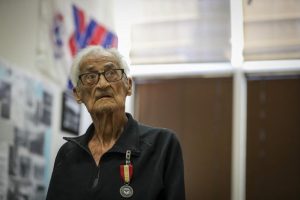Editor’s Note: This story includes discussion of suicide and suicidal ideation. Names of individuals have been withheld to protect their, and their families’, privacy.
The opinions expressed in this op-ed are those of the author and do not necessarily reflect the views of Military.com. If you would like to submit your own commentary, please send your article to opinions@military.com for consideration.
When Colonel G. killed himself in his office, the rest of us navigated our individual and collective grief through the heavy fog that lingers every time we lose a friend and mentor. Some sat at quiet conference tables trying to rationalize the unimaginable.
“Christ, I wonder what was wrong. He had a loving family.”
“I don’t know. It sucks.”
Others searched their memory for a red flag or missed opportunity to intervene. Some were angry with him for not reaching out and setting an example. Some just cried and shared stories of other friends who had killed themselves.
Our leaders are supposed to be beacons — caring for us and showing us how to navigate our challenges. Army leaders know the resources available to them and often manage them, training others and ensuring their effectiveness. But according to the Department of Defense’s annual report on Suicide Prevention, these leaders take their own lives at the same rate as those they are supposed to lead.
Why? If our systems work, those with the most knowledge and access should have lower suicide rates. The Army has a robust mental health support system, but current policy deters leaders from seeking help because it lacks privacy and strips them of agency over their care.
A few years earlier, I had talked with a young soldier, Private First Class L., for hours discussing her mental health. She had told her friend she didn’t “want to live anymore” after a bad breakup, and the friend called her leadership, who reported to me. I believed she wasn’t a threat to herself, and we agreed she would seek therapy on her terms and come to me if she needed help. But when my boss disagreed, she was admitted into the Army’s treatment program. After weeks of mandatory therapy and missing work for appointments, the unit psychologist agreed with my assessment. Pfc. L. got more help than she wanted or needed, and now everyone at work knew something about her personal life.
Privacy is often the first casualty in the effort to destigmatize mental health. Yet, even when stigma is reduced or eliminated, our processes make mental health care far more public than soldiers want or need. For leaders, who carry the burden of responsibility for their subordinates, the cost of disclosure is even higher. If one seeks help, they risk publicizing their private struggles, even if the process functions perfectly.
When attempting to access more private services, leaders face additional barriers. For example, chaplains are capable of handling confidential, routine support. Most soldiers live and work separately from the chaplain’s office, so they don’t see their “therapist” at work. Officers, however, spend most of their careers at headquarters alongside the chaplain. Senior officers, like Colonel G., are often the chaplain’s direct supervisor. Naturally, this makes leaders more hesitant to seek help from someone they will have to see every day.
Further away from the unit, leaders and soldiers use the same behavioral health facility. A leader considering care knows they risk seeing their immediate subordinates in the waiting room, which deters many from seeking help at all. Military bases are small communities, and the risk of being recognized increases with seniority. While in working groups to destigmatize mental health, I have listened to officers encourage each other to seek therapy off-base. Therapists who accept cash do not report treatment to military insurance. The hypocrisy seemed utterly lost on the officers as they also discussed how to convince soldiers that there are no professional costs to seeking care.
Aggressive anti-suicide programs can make any soldier less likely to reach out. Is the occasional daydream about jumping off a building worth getting put on 24-hour watch in the battalion headquarters? Is a lingering feeling of dread worth medications that could lead to a medical discharge?
These concerns are not unique to leaders, but leader suicide rates are a litmus test for program efficacy. Suicide prevention efforts revolve around creating and communicating programs, but we must measure their effectiveness by how leaders, the active managers and advocates, use those services themselves. When a soldier takes their own life, we redouble efforts to educate troops about existing programs, but that is not the problem. A soldier can Google a hotline or the chaplain’s phone number. What they lack is trust — trust that a friend or leader will listen to them without making it public or forcing them into an unwanted treatment program.
Until we earn the trust of our soldiers by treating them with respect, giving them agency, and maintaining their privacy, we will continue to lose high-performing leaders who view the cost as too high to take the first step toward care.
Veterans and service members experiencing a mental health emergency can call the Veteran Crisis Line, 988 and press 1. Help also is available by text, 838255, and via chat at VeteransCrisisLine.net.
— Maj. Dan Dillenback is a military strategist with the U.S. Army currently pursuing a master’s degree in public administration at Harvard University’s Kennedy School of Government in Cambridge, Massachusetts.
Please rate this CIBA article
Vote






